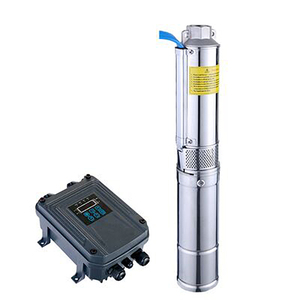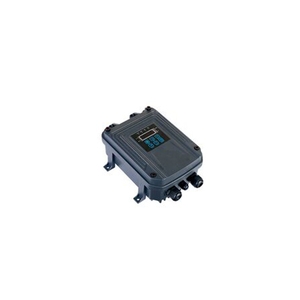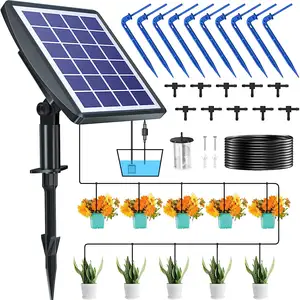(1638 products available)
















































































































































































































































The solar drip irrigation is a method of using solar power to produce electricity for drip irrigation. It is used to water plants and crops. There are two main types of solar drip irrigation systems: grid-tied and off-grid. Each of these has its benefits and is suitable for different situations.
A grid-tied solar drip system is connected to the main power grid. The solar panels primarily generate electricity to run the irrigation pump. Any extra power produced can be sent back to the grid. This type of system is advantageous for users who want to ensure a constant power supply. If the solar system does not produce enough power, the user can draw electricity from the grid to supplement it. This system can be more cost-effective, especially if the local power company offers net metering, which means the user can get credits for the excess power they return to the grid.
An off-grid solar drip irrigation system is not connected to the primary power supply. It uses batteries to store any surplus power generated. These batteries can then be employed to run the irrigation system at night or on cloudy days when solar power is not available. This type of system is ideal for areas with no access to the power grid. It can offer energy independence and work well in remote locations. Off-grid systems need careful design because they must meet all the energy needs without any external support.
A hybrid solar irrigation system combines solar power with other energy sources, such as wind or a small generator. This combination offers more flexibility and reliability. The wind or generator can serve as a backup when there is not enough sunlight. The solar panels are also useful in reducing the overall energy costs. The system switches automatically between the power sources based on the availability of each. This hybrid system is beneficial to users who want a reliable water supply. It can be more expensive to set up than the other systems, but it provides a good solution for areas with varying weather patterns.
The design of the solar powered drip irrigation system is simple and easy to use. It consists of a few key components that work well together to provide efficient watering for plants in a garden or field. The main components include:
The solar panel is the most important part of the system. It is responsible for converting sunlight into electricity, which powers the entire system. The panel can be mounted on a pole, roof, or any other structure that gets plenty of sunlight. It is designed to be durable and weather-resistant.
The battery stores the electricity generated by the solar panel. It ensures that the system can operate even when there is no sunlight. The battery is often a deep-cycle lead-acid or lithium-ion battery, chosen for its ability to withstand frequent charging and discharging.
The charge controller is a small electronic device that regulates the flow of electricity between the solar panel and the battery. It prevents overcharging and over-discharging, which can damage the battery. It also optimizes charging efficiency.
These are the parts that deliver the water to the plants. The drip lines are usually made of polyethylene and have built-in emitters that release water in controlled amounts directly to the plant roots. They are designed to be durable and resist clogging. The emitters can be adjustable to control the flow rate as needed for different plants.
The system needs a water source, which can be a well, stream, or storage tank. A filter is usually installed to remove sediment and debris that could clog the drip lines. The filter ensures that the system works properly and extends the life of the drip lines.
The controller or timer is the brain of the system. It allows users to set specific watering schedules based on the plant's needs. The timer can be battery-powered or connected to the main power supply. It can be programmed using buttons or a digital interface. It controls when the system waters the plants, helping to conserve water and ensure that the plants receive the right amount of water.
The supporting structure includes the poles, stakes, and connectors needed to install the drip lines. They hold everything in place and ensure that the lines are positioned correctly over the plants.
Valves and fittings are used to control the flow of water and connect different parts of the system. They are essential for proper operation and for adjusting the flow of water to different parts of the field or garden.
Solar drip watering system are useful in a wide range of applications. It can be used in different climates and landscapes to enhance water efficiency and increase plant production. In the Middle East and Africa, small-scale farmers increasingly incorporate solar drip irrigation systems, which are helpful in reducing reliance on seasonal rainfall and manual watering. The technology allows them to grow crops throughout the year, thus boosting food security and income.
In commercial agriculture, solar powered drip irrigation system are commonly found in vineyards, orchards, and row crops. The system can meet the specific water needs of plants at different growth stages while keeping production costs down. Moreover, with increasing concerns about water scarcity and the need for sustainable agricultural practices, many farms around the world have started using solar-powered drip irrigation. This, in turn, helps to reduce energy costs and pressure on the grid.
Vegetable gardens and backyard farms can also benefit from solar drip irrigation systems. In urban and peri-urban areas, where space and water resources are limited, the system can be easily integrated into existing gardening setups. It enables precise watering, which is crucial for growing healthy plants in a limited area. Furthermore, schools and community gardens have adopted solar-powered irrigation systems to educate people about water-saving technologies and promote self-sufficiency.
Another important application of solar drip irrigation is in arid and semi-arid regions. The system can alleviate the effects of drought and desertification, thus enabling sustainable land use and environmental conservation. Additionally, in remote off-grid areas, where electricity is scarce, solar-powered drip irrigation provides a reliable solution for water-efficient agriculture. It can also be a promising tool for disaster relief and development projects, ensuring that communities have access to clean water for farming. Generally, solar-powered drip irrigation systems are versatile and can be adapted to various settings, thereby contributing to the overall goal of water conservation and food security.
When it comes to choosing a solar drip irrigation system, the following factors should be taken into account.
Considering the location and climate is crucial. Solar panels need to be positioned where they can collect the most sunlight. In areas with long and sunny days, systems with batteries for storing energy can be the right choice. In places with more fluctuating weather, grid-tied systems that can draw power from the electrical grid on cloudy days can be more suitable.
The type of water source and its quality are also important factors. Drip irrigation systems are more compatible with solar power. They work with lower-quality sources such as wells or canals, and they also reduce evaporation and keep the soil moisture constant. Solar-powered pumps can handle water with some sediment and small debris. They are also more efficient with water than surface irrigation, which can lead to waterlogging and soil salinity.
It is essential to determine the size of the system needed by estimating the total water flow requirements of the irrigation system and the number of hours of sunlight available. It is also better to plan for future expansion if needed.
If there are frequent power outages, choosing a system with battery backup makes more sense. The battery stores excess power generated during the day for use at night. The grid-tied system allows the excess energy to be supplied back to the grid, and the user earns credits against the power consumed during the night or when there is no sunshine.
The quality of components, like the solar panels, pumps, filters, and drip lines, also needs to be considered. They are advised to be corrosion-resistant and designed for continuous solar operation.
Before choosing a solar drip irrigation system, it is important to check the availability of technical support and the warranty provided by the supplier. It should be ensured that the supplier can offer maintenance services and prompt support in case of any issues.
Q1: What are the benefits of a solar-powered irrigation system?
A1: Solar-powered irrigation systems use solar energy, which is a renewable and clean source of energy. They reduce electricity costs and are more environmentally friendly. Solar panels have a long lifespan and require little maintenance, making them a reliable and cost-effective solution for irrigation.
Q2: What factors should be considered when selecting a solar-powered drip irrigation system?
A2: Some of the factors to consider when selecting a solar-powered drip irrigation system include the size of the area to be irrigated, the type of crops being grown, the water source, the solar panel efficiency, and the system's design and features.
Q3: What are some of the challenges with using a solar-powered irrigation system?
A3: Solar-powered irrigation systems are reliant on sunlight, so they may not work efficiently during cloudy weather or at night. The initial cost of setting up a solar-powered irrigation system can be expensive, even though they save money in the long term. Additionally, they require regular maintenance to ensure that all components are functioning correctly.
Q4: How can the water supply be managed efficiently with a solar-powered drip irrigation system?
A4: Solar-powered drip irrigation systems can be combined with water-saving technologies, such as soil moisture sensors and automatic timers, to ensure that water is used efficiently. These systems can also be designed to use water from sources like wells or rivers.
Q5: How long does a solar-powered irrigation system last?
A5: With proper maintenance, a solar-powered irrigation system can last for more than 20 years. The solar panels, which are the primary components, have a lifespan of about 25 years.